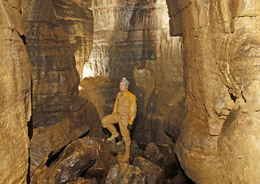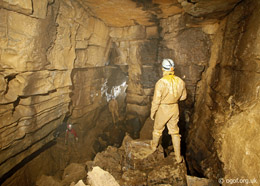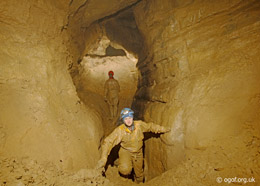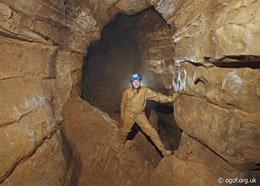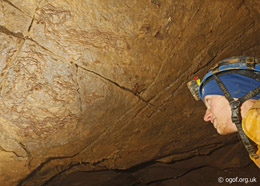Overview
Mostly HorridLength 1200m +
Altitude 524m
Grid SO 14088 15408
History
Ogof Cynnes was discovered by Martyn Farr in 1967, the warm air that rising from the cave gave away it's location by melting away the frost from around the entrance. This warm air led to the naming of the cave, Cynnes being the Welsh for warm. In 1993 a group of cavers from Morgannawg Caving Club dug through a mud filled passage at the end of the Right Hand Series to discover Lourdes Passage and the Easter Series, adding a total of about 400m of passage to the cave.
Location
Ogof Cynnes is located in the middle of Mynydd Llangynidr, and is best approached by walking across the moors from Blaen Onneu Quarry to the east. The cave is located in the upper side of a very long elongated shakehole, the entrance being a slot between gritstones that cap the limestone in this area.Central Northern Outcrop Google map showing the location of Ogof Cynnes and other caves in the area.
Location map - click marker to show entrance photo
Access
Open access.
Description
The entrance is a slot between blocks of millstone grit in the side of the shakehole which takes a small stream of water in wet weather. This drops down a short slope of boulders to a small chamber on the gritstone limestone boundary. The route ahead is a rift that passes the top of the first (blind) 5m pot on the right, while ahead and to the left low down is Talk Back a small passage that opens out into a rift below. Talk Back passage starts very tight and has to be passed high up avoiding dropping down as it pinches in. This route is not suitable for people above average build. After a body length or so you emerge onto a pile of boulders that can be climbed down to gain access to a walking size passage with a dry mud floor. This passage is a bat roost so should not be used in the winter months. The passage leads to a breakdown chamber below the shakehole to the left, while the way on is to the right. Following the right hand passage leads to a multiway junction. To the left at this junction leads to a pot with several ways on that all lead to a small breakdown chamber. Back at the junction the route straight ahead leads to a rift passage that veers right to lead you to a boulder choke and the Main Chamber. The right hand route from the junction leads into a larger passage through deep glutinous mud that veers to the left past a low arch and ends at the boulder choke and the route to the Main Chamber. The low arch that is passed is the entry point from the route in from the Second Pot.The alternative Second Pot route from the entrance is to continue in the rift passage that passes the First Pot until a low passage on the right is encountered. This leads down a sloping passage with a slot in the floor to reach the top of the Second Pot - a 5m pitch. A ladder can be rigged from boulders in the passage leading to the pitch head. From the bottom of the pitch a climb up a slippy mud bank leads to a crawl over mud. This crawl continues until you have to drop down the incredibly slippy Muddy Slot which can prove very difficult on the way back out, a clean handline will assist the return. At the bottom of the slot glutinous mud is encountered and you soon have to lie in it to pass through the low arch to gain the muddy passage described in the first route. If you continue past the low arch the passage becomes a much tighter rift and ends at the boulder choke.
At the boulder choke climbing up the boulders until a route through can be seen on the left takes you to a boulder landing overlooking the Main Chamber. A knotted handline assists the 2m climb down the right hand wall to drop you into the upper end of this large boulder floored chamber. At the lower end of the chamber are two routes off leading to the Left and Right Hand Series.
The Left Hand Series starts on the left as a large ascending passage with glutinous mud to wade through. The height of the passage lowers and in places you have to crawl or squeeze through fallen boulders. This passage then takes a sharp right hand turn and then after a short distance opens out high up in a large chamber - The Rat Trap. Immediately as you enter the chamber is a very large boulder is peeling away in the roof and looks like it could fall at any time. As you descend the boulders in the chamber there are several passages that radiate off. All have mud floors and start off with generous proportions, but all end in chokes after about 20m.
Back in the Main Chamber, the Right Hand Series starts off as an ascent up a high rift passage, but again the passage reduces in height. An abandoned dig can be seen on the left before the passage continues as a low muddy crawl ahead. This reaches a T junction with the way on being to the left. Following this crawl meets a rift passage in the floor after going around a sharp right hand bend. This can be climbed down to gain access to Square Passage on the left which soon reaches a chamber with a way off to the left that closes down. To the right the passage continues large to reach a boulder choke that can be climbed up to gain a chamber above, with no ways on. Below the boulder choke to the right is Snake Passage that becomes a tortuous muddy tube that leads to the Boulder Chambers area of the cave.
The way on is to pass over the route down to Square Passage and continue to crawl. This takes a sharp right turn before a drop in the floor level allows you to stand up and soon the passage opens out large and wide. The passage forks left and right, in both directions huge walls of mud rise up to within a few centimetres of the roof. To the right climbing up the mud wall reaches a low space in the roof of the passage that closes down after 15m. The route on is to take the left hand fork, where a climb up using the dug out holds in the vertical mud face leads to a a few feet of low passage before a similar size drop into the passage beyond is reached. Here a junction with large boulders is encountered. To the left a tall rift leads to a further mud bank that can be climbed to reach the Boulder Chambers area via an alternative route. In the floor between boulders leads to Titch Pot that ends too tight. To the right at floor level ends in a vertical mud wall. The way on is to climb up over the boulders to reach a high level landing up above the passage. A traverse along this ledge leads to Roof Passage which continues over mud fill as a hands and knees crawl for about 40m. Three passages are passed, with the main route being ahead. A dug out 'U bend' is then encountered which was the original breakthrough into the Easter Series. The passage ahead is larger and meets a low arch on the right. The large Lourdes Passage continues off to the left while closing down to the right. At end of the left section of Lourdes Passage a flat out crawl on the right leads to the low Five Ways Chamber. The way on is across this an up through boulders into a larger passage. The passages beyond this point are in gritstone. The passage turns left to end in the further reaches of the Easter Series, while ahead at the left junction a 4m pitch drops into some lower chambers.
The chambers at the bottom of the pitch in the Easter series have a passage that trends off towards the bottom of the First Pot in the Entrance Series, where it is speculated that a connection could be dug between the two.
Tackle
1st Pot pitch 5m ladder plus long belay.2nd Pot pitch 5m ladder plus long belay.
Easter Series pitch 4m ladder plus belay.
References
Cambrian Cave Registry for Ogof Cynnes UK Caving Wiki Entry (with very detailed description) for Ogof Cynnes
Descent 112 Article p30-31 on Oogf Cynnes Easter Series Extensions | Dave Glover
Caves of South Wales | Tim Stratford | ISBN: 1-871890-03-9 | Published by Cordee
The Caves of the Central Northern Outcrop | Tony Oldham
Warnings
The cave is notorious for the copious amounts of mud, which combined with some tight passages and a number of climbs can make the return journey quite arduous.
Disclaimer
The photographs and information of this page has been provided to help cavers planning trips. Caving can be a dangerous activity, if you are interested in exploring caves please join a caving club so you can enjoy a safe introduction to this sport. Local caving clubs are listed on the links page or you can visit the 'New To Caving' website for more options.If you feel that any of the information is incorrect or should be updated please contact us.


